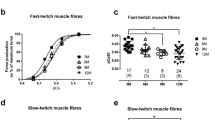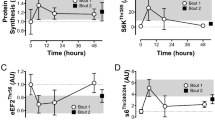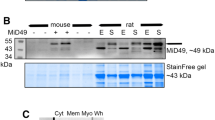Abstract
Laboratory rats are sedentary if housed in conditions where activity is limited. Changes in muscle characteristics with chronic inactivity were investigated by comparing sedentary rats with rats undertaking voluntary wheel running for either 6 or 12 weeks. EDL (type II fibers) and soleus (SOL) muscles (predominantly type I fibers) were examined. When measured within 1–2 h post-running, calcium sensitivity of the contractile apparatus was increased, but only in type II fibers. This increase disappeared when fibers were treated with DTT, indicative of oxidative regulation of the contractile apparatus, and was absent in fibers from rats that had ceased running 24 h prior to experiments. Specific force production was ~ 10 to 25% lower in muscle fibers of sedentary compared to active rats, and excitability of skinned fibers was decreased. Muscle glycogen content was ~ 30% lower and glycogen synthase content ~ 50% higher in SOL of sedentary rats, and in EDL glycogenin was 30% lower. Na+, K+-ATPase α1 subunit density was ~ 20% lower in both EDL and SOL in sedentary rats, and GAPDH content in SOL ~ 35% higher. There were no changes in content of the calcium handling proteins calsequestrin and SERCA, but the content of CSQ-like protein was increased in active rats (by ~ 20% in EDL and 60% in SOL). These findings show that voluntary exercise elicits an acute oxidation-induced increase in Ca2+ sensitivity in type II fibers, and also that there are substantial changes in skeletal muscle characteristics and biochemical processes in sedentary rats.








Similar content being viewed by others
References
Adams GR, Caiozzo VJ, Baldwin KM (2003) Skeletal muscle unweighting: spaceflight and ground-based models. J Appl Physiol (1985) 95:2185–2201
Allen DG, Lamb GD, Westerblad H (2008) Skeletal muscle fatigue: cellular mechanisms. Physiol Rev 88:287–332
Bortolotto SK, Cellini M, Stephenson DG, Stephenson GM (2000) MHC isoform composition and Ca(2+)- or Sr(2+)-activation properties of rat skeletal muscle fibers. Am J Physiol Cell Physiol 279:C1564-1577
Brocca L, Longa E, Cannavino J, Seynnes O, de Vito G, McPhee J, Narici M, Pellegrino MA, Bottinelli R (2015) Human skeletal muscle fibre contractile properties and proteomic profile: adaptations to 3 weeks of unilateral lower limb suspension and active recovery. J Physiol 593:5361–5385
Broch-Lips M, de Paoli F, Pedersen TH, Overgaard K, Nielsen OB (2011) Effects of 8 wk of voluntary unloaded wheel running on K+ tolerance and excitability of soleus muscles in rat. J Appl Physiol (1985) 111:212–220
Cala SE, Scott BT, Jones LR (1990) Intralumenal sarcoplasmic reticulum Ca(2+)-binding proteins. Semin Cell Biol 1:265–275
Chevessier F, Marty I, Paturneau-Jouas M, Hantai D, Verdiere-Sahuque M (2004) Tubular aggregates are from whole sarcoplasmic reticulum origin: alterations in calcium binding protein expression in mouse skeletal muscle during aging. Neuromuscul Disord 14:208–216
Christ-Roberts CY, Pratipanawatr T, Pratipanawatr W, Berria R, Belfort R, Kashyap S, Mandarino LJ (2004) Exercise training increases glycogen synthase activity and GLUT4 expression but not insulin signaling in overweight nondiabetic and type 2 diabetic subjects. Metab Clin Exp 53:1233–1242
Chua M, Dulhunty AF (1988) Inactivation of excitation-contraction coupling in rat extensor digitorum longus and soleus muscles. J Gen Physiol 91:737–757
Culligan K, Banville N, Dowling P, Ohlendieck K (2002) Drastic reduction of calsequestrin-like proteins and impaired calcium binding in dystrophic mdx muscle. J Appl Physiol 92:435–445
Desplanches D, Mayet MH, Sempore B, Flandrois R (1987) Structural and functional responses to prolonged hindlimb suspension in rat muscle. J Appl Physiol (1985) 63:558–563
Dutka TL, Mollica JP, Lamboley CR, Weerakkody VC, Greening DW, Posterino GS, Murphy RM, Lamb GD (2017) S-nitrosylation and S-glutathionylation of Cys134 on troponin I have opposing competitive actions on Ca2+ sensitivity in rat fast-twitch muscle fibers. Am J Physiol Cell Physiol 312:C316-c327
Ebashi S (1972) Calcium ions and muscle contraction. Nature 240:217–218
Fitts RH, Metzger JM, Riley DA, Unsworth BR (1986) Models of disuse: a comparison of hindlimb suspension and immobilization. J Appl Physiol (1985) 60:1946–1953
Froemming GR, Ohlendieck K (2001) The role of ion-regulatory membrane proteins of excitation-contraction coupling and relaxation in inherited muscle diseases. Front Biosci 6:D65–D74
Froemming GR, Murray BE, Harmon S, Pette D, Ohlendieck K (2000) Comparative analysis of the isoform expression pattern of Ca(2+)-regulatory membrane proteins in fast-twitch, slow-twitch, cardiac, neonatal and chronic low-frequency stimulated muscle fibers. Biochim Biophys Acta 1466:151–168
Gallo M, Gordon T, Syrotuik D, Shu Y, Tyreman N, MacLean I, Kenwell Z, Putman CT (2006) Effects of long-term creatine feeding and running on isometric functional measures and myosin heavy chain content of rat skeletal muscles. Pflugers Arch 452:744–755
Garvey SM, Russ DW, Skelding MB, Dugle JE, Edens NK (2015) Molecular and metabolomic effects of voluntary running wheel activity on skeletal muscle in late middle-aged rats. Physiol Rep 3:E12319
Hayes A, Williams DA (1996) Beneficial effects of voluntary wheel running on the properties of dystrophic mouse muscle. J Appl Physiol (1985) 80:670–679
Heinemeier KM, Olesen JL, Schjerling P, Haddad F, Langberg H, Baldwin KM, Kjaer M (2007) Short-term strength training and the expression of myostatin and IGF-I isoforms in rat muscle and tendon: differential effects of specific contraction types. J Appl Physiol 102:573–581
Henriksen EJ, Halseth AE (1995) Adaptive responses of GLUT-4 and citrate synthase in fast-twitch muscle of voluntary running rats. Am J Physiol 268:R130-134
Ishihara A, Roy RR, Ohira Y, Ibata Y, Edgerton VR (1998) Hypertrophy of rat plantaris muscle fibers after voluntary running with increasing loads. J Appl Physiol (1985) 84:2183–2189
Kariya F, Yamauchi H, Kobayashi K, Narusawa M, Nakahara Y (2004) Effects of prolonged voluntary wheel-running on muscle structure and function in rat skeletal muscle. Eur J Appl Physiol 92:90–97
Kim JH, Thompson LV (2013) Inactivity, age, and exercise: single-muscle fiber power generation. J Appl Physiol (1985) 114:90–98
Kriketos AD, Pan DA, Sutton JR, Hoh JF, Baur LA, Cooney GJ, Jenkins AB, Storlien LH (1995) Relationships between muscle membrane lipids, fiber type, and enzyme activities in sedentary and exercised rats. Am J Physiol Regul Integr Comp Physiol 269:R1154–R1162
Lamb GD (2002) Excitation-contraction coupling and fatigue mechanisms in skeletal muscle: studies with mechanically skinned fibres. J Muscle Res Cell Motil 23:81–91
Lamb GD, Stephenson DG (1990) Calcium release in skinned muscle fibres of the toad by transverse tubule depolarization or by direct stimulation. J Physiol 423:495–517
Lamb GD, Stephenson DG (1994) Effects of intracellular pH and [Mg2+] on excitation-contraction coupling in skeletal muscle fibres of the rat. J Physiol 478(Pt 2):331–339
Lamboley CR, Wyckelsma VL, Dutka TL, McKenna MJ, Murphy RM, Lamb GD (2015) Contractile properties and sarcoplasmic reticulum calcium content in type I and type II skeletal muscle fibres in active aged humans. J Physiol 593:2499–2514
Lamboley CR, Wyckelsma VL, Perry BD, McKenna MJ, Lamb GD (2016) Effect of 23-day muscle disuse on sarcoplasmic reticulum Ca2+ properties and contractility in human type I and type II skeletal muscle fibers. J Appl Physiol (1985) 121:483–492
Larsen S, Nielsen J, Hansen CN, Nielsen LB, Wibrand F, Stride N, Schroder HD, Boushel R, Helge JW, Dela F, Hey-Mogensen M (2012) Biomarkers of mitochondrial content in skeletal muscle of healthy young human subjects. J Physiol 590:3349–3360
Larsson L, Li X, Berg HE, Frontera WR (1996) Effects of removal of weight-bearing function on contractility and myosin isoform composition in single human skeletal muscle cells. Pflugers Arch 432:320–328
Mollica JP, Dutka TL, Merry TL, Lamboley CR, McConell GK, McKenna MJ, Murphy RM, Lamb GD (2012) S-glutathionylation of troponin I (fast) increases contractile apparatus Ca2+ sensitivity in fast-twitch muscle fibres of rats and humans. J Physiol 590:1443–1463
Mondon CE, Dolkas CB, Sims C, Reaven GM (1985) Spontaneous running activity in male rats: effect of age. J Appl Physiol (1985) 58:1553–1557
Murphy RM, Lamb GD (2013) Important considerations for protein analyses using antibody based techniques: down-sizing Western blotting up-sizes outcomes. J Physiol Lond 591:5823–5831
Murphy RM, Watt KK, Cameron-Smith D, Gibbons CJ, Snow RJ (2003) Effects of creatine supplementation on housekeeping genes in human skeletal muscle using real-time RT-PCR. Physiol Genom 12:163–174
Murphy RM, Larkins NT, Mollica JP, Beard NA, Lamb GD (2009a) Calsequestrin content and SERCA determine normal and maximal Ca2+ storage levels in sarcoplasmic reticulum of fast- and slow-twitch fibres of rat. J Physiol 587:443–460
Murphy RM, Mollica JP, Lamb GD (2009b) Plasma membrane removal in rat skeletal muscle fibers reveals caveolin-3 hot-spots at the necks of transverse tubules. Exp Cell Res 315:1015–1028
Murphy RM, Xu H, Latchman H, Larkins NT, Gooley PR, Stapleton DI (2012) Single fiber analyses of glycogen-related proteins reveal their differential association with glycogen in rat skeletal muscle. Am J Physiol Cell Physiol 303:C1146–C1155
Murray BE, Froemming GR, Maguire PB, Ohlendieck K (1998) Excitation-contraction-relaxation cycle: role of Ca2+-regulatory membrane proteins in normal, stimulated and pathological skeletal muscle (review). Int J Mol Med 1:677–687
Nielsen J, Holmberg HC, Schroder HD, Saltin B, Ortenblad N (2011) Human skeletal muscle glycogen utilization in exhaustive exercise: role of subcellular localization and fibre type. J Physiol 589:2871–2885
Parker GJ, Koay A, Gilbert-Wilson R, Waddington LJ, Stapleton D (2007) AMP-activated protein kinase does not associate with glycogen alpha-particles from rat liver. Biochem Biophys Res Commun 362:811–815
Pedersen TH, Nielsen OB, Lamb GD, Stephenson DG (2004) Intracellular acidosis enhances the excitability of working muscle. Science 305:1144–1147
Perry BD, Wyckelsma VL, Murphy RM, Steward CH, Anderson M, Levinger I, Petersen AC, McKenna MJ (2016) Dissociation between short-term unloading and resistance training effects on skeletal muscle Na+,K+-ATPase, muscle function, and fatigue in humans. J Appl Physiol (1985) 121:1074–1086
Posterino GS, Lamb GD (2003) Effect of sarcoplasmic reticulum Ca2+ content on action potential-induced Ca2+ release in rat skeletal muscle fibres. J Physiol 551:219–237
Powers SK, Jackson MJ (2008) Exercise-induced oxidative stress: cellular mechanisms and impact on muscle force production. Physiol Rev 88:1243–1276
Prats C, Helge JW, Nordby P, Qvortrup K, Ploug T, Dela F, Wojtaszewski JF (2009) Dual regulation of muscle glycogen synthase during exercise by activation and compartmentalization. J Biol Chem 284:15692–15700
Prats C, Gomez-Cabello A, Hansen AV (2011) Intracellular compartmentalization of skeletal muscle glycogen metabolism and insulin signalling. Exp Physiol 96:385–390
Rebbeck RT, Karunasekara Y, Board PG, Beard NA, Casarotto MG, Dulhunty AF (2014) Skeletal muscle excitation-contraction coupling: who are the dancing partners? Int J Biochem Cell Biol 48:28–38
Redl C, Gfoehler M, Pandy MG (2007) Sensitivity of muscle force estimates to variations in muscle-tendon properties. Hum Mov Sci 26:306–319
Ren JM, Semenkovich CF, Gulve EA, Gao J, Holloszy JO (1994) Exercise induces rapid increases in GLUT4 expression, glucose transport capacity, and insulin-stimulated glycogen storage in muscle. J Biol Chem 269:14396–14401
Rockl KS, Hirshman MF, Brandauer J, Fujii N, Witters LA, Goodyear LJ (2007) Skeletal muscle adaptation to exercise training: AMP-activated protein kinase mediates muscle fiber type shift. Diabetes 56:2062–2069
Rodnick KJ, Reaven GM, Haskell WL, Sims CR, Mondon CE (1989) Variations in running activity and enzymatic adaptations in voluntary running rats. J Appl Physiol (1985) 66:1250–1257
Rodnick KJ, Henriksen EJ, James DE, Holloszy JO (1992) Exercise training, glucose transporters, and glucose transport in rat skeletal muscles. Am J Physiol 262:C9-14
Ryu JH, Drain J, Kim JH, McGee S, Gray-Weale A, Waddington L, Parker GJ, Hargreaves M, Yoo SH, Stapleton D (2009) Comparative structural analyses of purified glycogen particles from rat liver, human skeletal muscle and commercial preparations. Int J Biol Macromol 45:478–482
Salanova M, Schiffl G, Gutsmann M, Felsenberg D, Furlan S, Volpe P, Clarke A, Blottner D (2013) Nitrosative stress in human skeletal muscle attenuated by exercise countermeasure after chronic disuse. Redox Biol 1:514–526
Steffen JM, Musacchia XJ (1984) Effect of hypokinesia and hypodynamia on protein, RNA, and DNA in rat hindlimb muscles. Am J Physiol 247:R728-732
Stephenson DG, Williams DA (1981) Calcium-activated force responses in fast-twitch and slow-twitch skinned muscle-fibers of the rat at different temperatures. J Physiol Lond 317:281–302
Talmadge RJ, Roy RR, Caiozzo VJ, Edgerton VR (2002) Mechanical properties of rat soleus after long-term spinal cord transection. J Appl Physiol (1985) 93:1487–1497
Thomason DB, Herrick RE, Surdyka D, Baldwin KM (1987) Time course of soleus muscle myosin expression during hindlimb suspension and recovery. J Appl Physiol (1985) 63:130–137
Trappe S, Trappe T, Gallagher P, Harber M, Alkner B, Tesch P (2004) Human single muscle fibre function with 84 day bed-rest and resistance exercise. J Physiol 557:501–513
Trinh HH, Lamb GD (2006) Matching of sarcoplasmic reticulum and contractile properties in rat fast- and slow-twitch muscle fibres. Clin Exp Pharmacol Physiol 33:591–600
Tristan C, Shahani N, Sedlak TW, Sawa A (2011) The diverse functions of GAPDH: views from different subcellular compartments. Cell Signal 23:317–323
Watanabe D, Kanzaki K, Kuratani M, Matsunaga S, Yanaka N, Wada M (2015) Contribution of impaired myofibril and ryanodine receptor function to prolonged low-frequency force depression after in situ stimulation in rat skeletal muscle. J Muscle Res Cell Motil 36:275–286
Widrick JJ, Trappe SW, Romatowski JG, Riley DA, Costill DL, Fitts RH (2002) Unilateral lower limb suspension does not mimic bed rest or spaceflight effects on human muscle fiber function. J Appl Physiol 93:354–360
Wyckelsma VL, McKenna MJ, Serpiello FR, Lamboley CR, Aughey RJ, Stepto NK, Bishop DJ, Murphy RM (2015) Single-fiber expression and fiber-specific adaptability to short-term intense exercise training of Na+-K+-ATPase alpha- and beta-isoforms in human skeletal muscle. J Appl Physiol (1985) 118:699–706
Wyckelsma VL, McKenna MJ, Levinger I, Petersen AC, Lamboley CR, Murphy RM (2016) Cell specific differences in the protein abundances of GAPDH and Na(+),K(+)-ATPase in skeletal muscle from aged individuals. Exp Gerontol 75:8–15
Xu H, Stapleton D, Murphy RM (2015) Rat skeletal muscle glycogen degradation pathways reveal differential association of glycogen-related proteins with glycogen granules. J Physiol Biochem 71:267–280
Xu H, Frankenberg NT, Lamb GD, Gooley PR, Stapleton DI, Murphy RM (2016) When phosphorylated at Thr148, the beta2-subunit of AMP-activated kinase does not associate with glycogen in skeletal muscle. Am J Physiol Cell Physiol 311:C35-42
Xu H, Lamb GD, Murphy RM (2017) Changes in contractile and metabolic parameters of skeletal muscle as rats age from 3 to 12 months. J Muscle Res Cell Motil. https://doi.org/10.1007/s10974-017-9484-6
Acknowledgements
This was supported by a National Health and Medical Research Council (Australia) Grant (APP1085331) to GDL and RMM.
Author information
Authors and Affiliations
Corresponding author
Rights and permissions
About this article
Cite this article
Xu, H., Ren, X., Lamb, G.D. et al. Physiological and biochemical characteristics of skeletal muscles in sedentary and active rats. J Muscle Res Cell Motil 39, 1–16 (2018). https://doi.org/10.1007/s10974-018-9493-0
Received:
Accepted:
Published:
Issue Date:
DOI: https://doi.org/10.1007/s10974-018-9493-0




